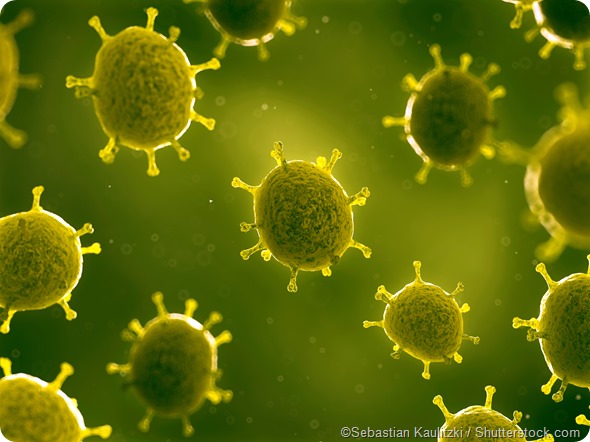Virus Purification Methods

There are several ways of purifying viruses. They are outlined below.
Ultracentrifugation
Ultracentrifugation is used to separate macromolecules into different component parts based on the size of the particles in the mixture. Different kinds of particles such as viruses, bacteria, and organelles have different sizes and will be driven away from the centrifugal axis in the equipment to different locations accordingly. This is called velocity sedimentation.
A viscous liquid such as glycerol, sucrose, or cellufine sulfate, available from companies such as AMSBIO, is used in the process to help control the rate of migration of the different kinds of particles or else the rate of their migration away from the axis will be too fast. A slower rate of migration helps to better purify the mixture. The usual aim is for the virus to move from the axis to halfway through the gradient.
Viruses such as human respiratory syncytial virus, a respiratory infection that mainly affect infants and children, can be separated by ultracentrifugation. Instead of sucrose, iodixanol is used as the gradient medium with magnesium sulphate used as a stabilizing agent and the chelating agent ethylenediaminetetraacetic acid (EDTA) to help break down the virus into constituent parts.

An alternative form of centrifugation called isopycnic density can also be used , which separates molecules based on their buoyancy density in the viscous fluid. The fluid has a greater density at the bottom than at the top. When the mixture is centrifuged, the particles, including the virus molecules, migrate to the level of the liquid which relates to their density.
A combination of both velocity sedimentation and isopycnic density centrifugation can be a particularly useful form of purification.
Chromatography
Chromatography is useful for purifying both enveloped and non-enveloped viruses. Most viruses are enveloped which mean that they have their nucleic acid (DNA and RNA) covered in a protein cover called the capsid which further has a membrane envelope on it.
Examples of enveloped viruses are the chickenpox virus and the influenza virus. Non-enveloped viruses do not have the envelope. Examples of these non-enveloped viruses are parvovirus and adeno virus. Non-enveloped viruses are not impacted by heat, drying or acids while enveloped viruses can be affected by these.
The level of purification varies from one virus to the next. Pore size has an impact on how much of the virus is removed and so does the kind of resin, protein solution, and buffer. It is also more difficult to remove smaller viruses fully with this method.
Some columns use calcium phosphate, usually at pH7. Elution rates can be changed by altering the pH level and impacting the phosphate concentration.
An example of a virus that can be treated with this method is the influenza virus. Purity can be improved by 30 to 100 fold. Further improvement can be made by employing an additional chromatography column which can improve the concentration by 10 to 30 fold.
Precipitation
This is a method where a salt such as ammonium sulphate is added to a protein solution to saturation levels until the virus precipitates. The amount of salt added to achieve this needs to be noted carefully. This method purifies the protein. It can be used with both enveloped and non-enveloped viruses.
Other factors can also affect how well this method works such as the temperature, pH, protein concentrations, and precipitation agents.
Nanofiltration
Nanofiltration is a membrane separation process which involves the diffusion of a solution through a membrane with a very small pore size. This method can be used for enveloped viruses and non-enveloped viruses. It is particularly good for obtaining small particles.
It has been more frequently used as a purification for plasma products that contain viruses such as hepatitis B and hepatitis C since the early 90s. It is viewed as a good method of separating out any viruses in the plasma and helping to prevent them entering human plasma stocks.
References
- http://www.els.net/WileyCDA/ElsArticle/refId-a0002969.html
- http://www.ncbi.nlm.nih.gov/pmc/articles/PMC2486346/
- http://www.microbiologyresearch.org/search?value1=virus+purification+techniques&option1=all&option2=pub_serialIdent&value2=&operator2=AND
- http://www2.gsu.edu/~biotkf/bio475/475lab3.htm
Further Reading
- All Laboratory Techniques Content
- Electrochemical Analysis
- Life Science Applications of Chromatography
- Thermal Analysis of Pharmaceutical Materials
- Using Dynamic Light Scattering (DLS) for Liposome Size Analysis
Last Updated: Feb 26, 2019

Written by
Deborah Fields
Deborah holds a B.Sc. degree in Chemistry from the University of Birmingham and a Postgraduate Diploma in Journalism qualification from Cardiff University. She enjoys writing about the latest innovations. Previously she has worked as an editor of scientific patent information, an education journalist and in communications for innovative healthcare, pharmaceutical and technology organisations. She also loves books and has run a book group for several years. Her enjoyment of fiction extends to writing her own stories for pleasure.
Source: Read Full Article